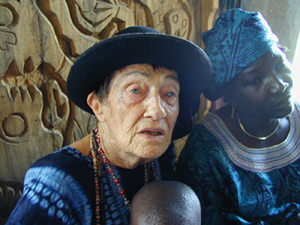Austrian Artist Becomes Nigerian Ancestor
How did an Austrian girl who was born into a Christian family end up as high priestess of a Yoruba goddess in Nigeria? Suzanne Wenger’s life demonstrates that people are just people after all, that is, when they put aside race, values, beliefs and the other things that divide us.
Something in my head keeps fitting Suzanne Wenger into the last paragraph of Ronald Reagan’s speech at the Westminster College Cold War Memorial in 1990. While wishing for “an end to walls wherever they divide the human race” and “the day when all God’s children live in a world without walls,” Reagan had concluded: “Maybe one day boundaries all over the Earth will disappear as people cross boundaries and find out that, yes, there is a brotherhood of man in every corner.”
Wenger certainly crossed that boundary. A veritable bridge between two very different worlds and cultures, she left her native Austria as a young woman and found her place among the Yoruba of Nigeria. Dubbed “the white priestess of black magic” by the international media, Wenger rose from novice seeker to high priestess of Osun, the spirit-goddess of the waters of life, who represents love and maternity in Yoruba mythology. Affectionately renamed Adunni Olorisha (“the cherished one who is deeply committed to the gods”), she lived among her adopted people and served their gods faithfully for 58 years until she died recently at the age of 93.
As rituals in honor of her soul were conducted according to Orisha burial traditions after she was laid to rest in the sacred grove of Osun in Osogbo, the Yoruba town she made her home, gurus of Yoruba traditional religion agreed that she had earned her place among “the living dead” and was being heralded into the fold of Yoruba ancestors. This sentiment was strongly expressed in tributes that marked her passing.
“Her internment completes Susan Wenger’s transformation into a spirit, as devotees will henceforth make supplications to her, too.”
“She is not dead. She lives through her works. She only has become an Orisha. She only slept, she didn’t die.”
“Susanne’s knowledge of the behavior and character of all the deities means she has actually become Yoruba.”
“She was well versed in the Yoruba pantheon of the gods with which she was actively engaged.”
“She was a significant member of the Yoruba cultural leaders.”
“She personified the spirit of the sacred grove, the river goddess to which she dedicated nearly her entire adult life, worshipping and adoring.”
Wenger was no ordinary adventurer/fun seeker who dazzled naïve Africans with her white skin and European accent. She worked her butt off, as Americans would say, to earn her ancestral stripes. Now, how did an Austrian girl who was born into a Christian family end up as high priestess and custodian-in-chief of the shrine of a Yoruba goddess?
Wenger was born during the First World War, in 1915, in the town of Graz, Austria. She studied art in Graz and Vienna, and was part of the famous Vienna “Art-Club.” She spent some time in Italy and Switzerland after World War II and had exhibitions with the most famous artists of the time in the gallery Des Eaux Vives in Zurich.
Wenger’s journey to Nigeria began in 1949 when she went to Paris, where she met Ulli Beier, a German linguist. They soon became an item. Beier accepted a posting as a phonetician at the University College, Ibadan (Nigeria) shortly after. However, he had to be married to take up the position, so the couple began to make wedding plans.
At the wedding in a registry office in London, the eclectic couple presented the registrar with a selection of curtain rings in place of the customary wedding rings. When the registrar protested, saying, “A wedding is not a silly joke,” they replied: “How do you know?”
They arrived in Ibadan in 1950 and settled into life there, Beier as a teacher and Wenger as an artist. From Ibadan they moved to Ede (another Yoruba town) to escape what Wenger called the “artificial university compound.” There, Beier continued to build his renown as a teacher, art/culture scholar and documentary expert and founded the Mbari Mbayo Cultural Movement, which was the precursor of modern Nigerian art and literature. Wenger, on the other hand, according to Beier, “quickly became part of the local culture.”
While this cultural integration was taking place, Wenger met Ajagemo, a powerful Obatala priest who became her guru and initiated her to traditional Yoruba religion and the world of Orishas. Wenger’s experience with Ajagemo was surreal. “He took me by the hand and led me into the spirit world,” she told a French documentary maker in 2005. “I did not speak Yoruba and he did not speak English. Our only intercourse was the language of the trees.”
Wenger was hooked. She was initiated as a priestess of Osun and Obatala. Beier said his wife found her ori inu (real essence) in the spirituality of Osun. When her transformation was complete, there was no going back. Nothing could take Wenger from her “Yoruba roots.” She resolved to stay in Oshogbo for the rest of her life. She and Beier separated and he returned to Europe. She stayed in Oshogbo and eventually married a traditional Yoruba drummer, Ayansola Oniru, who drummed the gods into frenzy for the acolyte.
Wenger went on to adopt 15 children whom she nurtured in the traditional Yoruba way. She breathed her last in their warm embrace even as she was properly heralded into “the other side” by the elements. According to accounts of her death, a sudden rain started around midday and ended abruptly in Oshogbo, the Yoruba town that was home to Wenger. Remarkably, this was in the middle of the dry season (Nigeria has two main seasons; the dry season and the rainy season). Immediately after the rain, Wenger asked, “What day of the week is it?” “What time of the day is it?” When she got the answers, she said, “It’s time to go. It’s good. It’s OK,” and took her last breath.
Wenger could not have departed in a different way. In one of her many interviews on spirituality, she had said, “All human activity is spiritual. You cannot do even an office job without its being spiritual activity. The spiritual aspect of life is the net of life. Life and spirituality are one.”
Adunni Olorisha came to be acclaimed as a champion of Yoruba traditional religion, especially in Oshogbo. According to an account given in a BBC interview, when she first made contact with the Yorubas, she found their traditional culture in decline and under threat of being wiped out by missionaries who branded it “black magic” or “juju.” She encouraged Yorubas not to give up their traditional ways, even though in many cases, not giving up traditional culture meant rejecting formal education. The schools were run by Muslim or Christian organizations that did not tolerate what they saw as pagan beliefs.
One of her adopted children, Sangodare Gbadegesin Ajala, recalls Wenger’s lessons in decolonization. The young Ajala had badly wanted to acquire Western education, but his father was a staunch devotee of the traditional Yoruba religion who refused to let his children go to school and be baptized into Christianity, as was the practice in those days. So there was no chance of him being educated as long as he was under his father’s ward. He thought a white woman would understand his thirst for Western education and help him fulfill his dream. He therefore found his way into Wenger’s life and moved in with her. But he was in for the shock of his life. Six months after moving in, he asked Wenger if he could go to school.
“She shouted: ‘No! You cannot go to school. They will turn you into a Christian and your life will be over!'” he remembers.
Though Ajala never got that Western education, he is highly educated in the traditions of Yoruba spirit gods. He is today the high priest of Sango, the lightning god. And from this vantage position, he says he realizes how important it is that Yoruba traditions have been preserved.
To ensure that children are not torn between getting a Western education and learning their own traditions as he was, Ajala plans to build a school where children receive Western education while learning about the traditions of the Orishas.
Although Wenger is internationally famous for her oil paintings, batiks and drawings, she reinvented her art for the Orishas she had come to know and love. She and a group of local artisans and devotees built statues in the sacred grove to celebrate and immortalize the gods. Said Wenger, “We took the essence of the gods and made the icons from those feelings, by connecting to the soul of the materials and building the statues to the gods from that soul. It is sacred art, built under the orders of the gods. Every sculpture is a shrine in which the god is invited to live.”
Wenger described the sacred grove of Oshogbo as “a refuge for homeless gods who have been abandoned by modern society.”
Islamization and Christianization certainly ensured that the gods and indeed traditional religion were kept in the cooler by many who could not reconcile them with their newfound faiths. Contrary to what the missionaries believed and propagated, however, traditional African belief is overwhelmingly monotheistic. There may be spirits and ancestors (very much like Christian angels and saints) guiding the affairs of the living, but there is only one God. Early missionaries got this all wrong and delighted in cataloging legions of “heathen gods” worshipped by “animist Africans.”
But Wenger found a meeting point between the Orishas and the new religions. She argued that “Orisha is merely a name which represents the supernatural forces which are basic expressions of life. It doesn’t matter what you call it. It is a ‘sacred force’ that represents the experience of life that informs human beingness. As with all religions, there is no true way to explain it along rational lines without leeching it of its meaning and intensely personal quality. You are a part of it and it is a part of you. You may, as so many have done, push it aside, but it remains in you, in all of us.”
She took great pains to try to get those who were torn between their traditional religion and their new faiths understand this.
Every Yoruba town had sacred groves that were sanctuaries or ceremonial homes for the gods. Christianization and Islamization had gradually eaten into the traditional religion, all but wiping out the groves. The Oshogbo grove was a lucky exception, all because of an Austrian woman. Without Wenger’s art and devotion, the virgin forest may well have been built over and lost forever, like so many others in Nigeria.
With the “New Sacred Art,” as the efforts of Wenger and her fellow artists came to be known, she transformed the sacred groves of Osun-Oshogbo into a garden filled with statues. Art historian Okwunodu Ogbechie describes them as “modernist sculptures inflected by the Gesamtkunstwerk aesthetics of late-modern Viennesse art, most famously concretized by the visionary artist Friedensreich Hundertwasser.”
According to Ogbechie, “It is hard to explain the overall impact of these sculptures. They have to be seen to be understood.” This may be because they are beyond art.
The grove was also beyond an ordinary forest to Wenger, as those who sought to gentrify it soon found out. Said Wenger, “Because the place is crowded by homeless gods, the spirits in the forest are strong.” She put everything on the line to protect the grove and its “homeless gods,” on one occasion lying in front of a bulldozer to prevent the trees and sculptures from being destroyed by a man who bought the grove and wanted to build a house there.
The sacred grove was later designated a national monument by the Nigerian government through the National Commission for Museums and Monuments. The icons that Wenger built for the gods and the other materials in the grove also were classified as antiquities.
The ultimate recognition of Wenger’s devotion to the grove and the tradition it represents came when the Osun grove was designated a world-class tourism site on the United Nations Educational, Scientific and Cultural Organization’s World Heritage List in 2005. Wenger’s efforts were crowned when she was named “Member of the Federal Republic,” a national honor in Nigeria.
Wenger’s physical form will be sorely missed at the Osun-Oshogbo festival this year. The festival, held to worship the river goddess, takes place at the sacred grove every August and attracts thousands of devotees and tourists from all over the world. Over the years, Wenger came to be known as a personification of the spirit of the river goddess and the moving force behind the festival.
It is certain that libations will be poured to the spirit of Adunni Olorisha at the festival. Many devotees will also send their supplications to Olodumare (God) and Osun (the river goddess) through her. Indeed, Suzanne Wenger “is not dead. She has only become an Orisha. She only slept, she didn’t die.”
Your support matters…Independent journalism is under threat and overshadowed by heavily funded mainstream media.
You can help level the playing field. Become a member.
Your tax-deductible contribution keeps us digging beneath the headlines to give you thought-provoking, investigative reporting and analysis that unearths what's really happening- without compromise.
Give today to support our courageous, independent journalists.






You need to be a supporter to comment.
There are currently no responses to this article.
Be the first to respond.